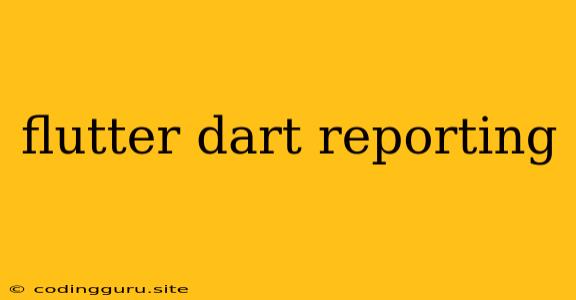Harnessing the Power of Flutter and Dart for Reporting
Flutter, with its powerful cross-platform capabilities and Dart's expressive syntax, has revolutionized app development. But how can you leverage this dynamic duo to create comprehensive and engaging reports? This article dives into the world of Flutter Dart reporting, exploring techniques and strategies to effectively present data within your applications.
Why Choose Flutter and Dart for Reporting?
Flutter's hot reload feature allows for rapid prototyping and iterative development, crucial for refining the layout and presentation of your reports. Dart, with its strong type system and focus on performance, ensures your reports are efficient and reliable.
Strategies for Building Effective Reports in Flutter and Dart
1. Utilizing Widgets for Visual Structure:
Flutter's rich widget library provides numerous options for structuring your reports. Here's how you can leverage them:
ColumnandRow: These widgets are fundamental for organizing elements in a vertical or horizontal fashion.Table: This widget is ideal for presenting tabular data with clear rows and columns.ListView: Perfect for displaying large datasets in a scrollable manner.GridView: Presents data in a grid layout, useful for visual representations.
2. Data Visualization with Charts and Graphs:
Flutter Dart reporting goes beyond simple text-based reports. Incorporate charts and graphs to visually represent your data:
charts_flutter: This package provides a wide range of chart types, including line charts, bar charts, pie charts, and more.syncfusion_flutter_charts: Offers a powerful charting library with advanced customization options.flutter_charts: A versatile library for creating customizable charts with high performance.
3. Employing Third-Party Packages:
Flutter's ecosystem is vast, providing specialized packages for enhancing Flutter Dart reporting:
pdf: Enables you to generate PDF reports with precise layout control.flutter_html_view: Displays HTML-formatted content within your reports.printing: Facilitates printing reports directly from your Flutter app.
4. Data Fetching and Processing:
To populate your reports with relevant data:
httppackage: Retrieve data from APIs using HTTP requests.sqflitepackage: Interact with local SQLite databases for storing and retrieving data.flutter_bloc: Implement state management to handle data updates and display changes in your reports.
Example: A Basic Flutter Dart Report
import 'package:flutter/material.dart';
import 'package:charts_flutter/flutter.dart' as charts;
void main() => runApp(MyApp());
class MyApp extends StatelessWidget {
@override
Widget build(BuildContext context) {
return MaterialApp(
home: MyHomePage(),
);
}
}
class MyHomePage extends StatefulWidget {
@override
_MyHomePageState createState() => _MyHomePageState();
}
class _MyHomePageState extends State {
List> _seriesData = [];
@override
void initState() {
super.initState();
_seriesData = [
charts.Series(
id: 'Sales',
colorFn: (_, __) => charts.MaterialPalette.blue.shadeDefault,
domainFn: (Sales sales, _) => sales.year,
measureFn: (Sales sales, _) => sales.sales,
data: [
Sales('2020', 100),
Sales('2021', 150),
Sales('2022', 200),
],
),
];
}
@override
Widget build(BuildContext context) {
return Scaffold(
appBar: AppBar(
title: Text('Flutter Dart Reporting'),
),
body: Center(
child: Column(
mainAxisAlignment: MainAxisAlignment.center,
children: [
Text(
'Sales Report',
style: TextStyle(fontSize: 24, fontWeight: FontWeight.bold),
),
SizedBox(height: 20),
Expanded(
child: charts.BarChart(
_seriesData,
animate: true,
barGroupingType: charts.BarGroupingType.grouped,
),
),
],
),
),
);
}
}
class Sales {
final String year;
final int sales;
Sales(this.year, this.sales);
}
Tips for Crafting Effective Flutter Dart Reports
- Keep it concise and focused: Avoid overwhelming users with unnecessary data.
- Use clear and consistent formatting: Ensure readability and visual appeal.
- Emphasize key insights: Highlight the most relevant data points with visuals and annotations.
- Provide interactivity: Allow users to filter, sort, and drill down into data.
- Test thoroughly: Validate report accuracy and ensure responsiveness across different devices.
Conclusion
Flutter Dart reporting empowers developers to create engaging and informative reports. By leveraging Flutter's rich widget library, powerful charting packages, and data handling techniques, you can build interactive reports that effectively communicate insights and enhance your applications.
